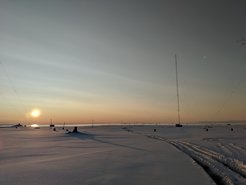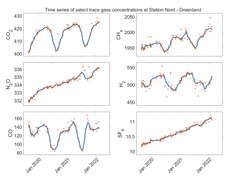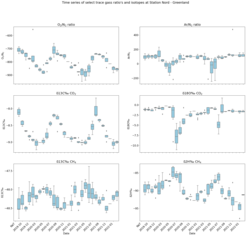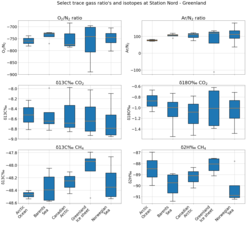Station North

Site description
Station North, also called Villum Research Station (http://villumresearchstation.dk), is a research facility at a military outpost in high arctic North Greenland (81°36’ N, 16°40’ W). It is owned by the Greenland Government and is being operated by Aarhus University (Denmark) in cooperation with the Danish Defense (the Arctic Command). Observations are part of the European ICOS observation network, and the MPG flask sampler has been integrated into this concept.
Instrument
Our flask sampler at Station North can be used for the automated collection of air samples (1 – 3 L) under standardized conditions. The sampler version used here is a smaller version compared to the standard ICOS design, consisting of just 3 drawers, therefore capable of holding up to 12 flasks at a time. The integrated software allows for a detailed monitoring of flow processes and flask status. Flasks are analyzed at MPI-BGC for the concentrations of CH4, CO2, CO, N2O, H2, and SF6. As additional parameters, we sample the ratios of O2/N2, Ar/N2, and the stable isotope signals d13C-CO2, d18O-CO2, d13C-CH4, and d2H-CH4.
Results
Operations at Station North started in September 2019. The below Figure summarizes the seasonal variability and mid-term trends for six major trace gases that are routinely quantified in the sampled flask air: CH4, CO2, CO, N2O, H2, and SF6.

Time series of trace gas ratios, and isotope signals
Figure 6 summarizes the measured times series of the O2/N2, Ar/N2 ratios, and the stable isotope signals for CO2 (d13C-CO2, d18O-CO2) and methane (d13C-CH4, and d2H-CH4). These signals primarily aim to support the interpretation of large-scale representative concentration levels of these components, potentially improving estimations of their continental fluxes with the help of inverse modelling. These data become particularly interesting when comparing results between different source regions for the air masses sampled.

Aggregated signals separating source regions of air masses
The analysis of time-integrated signals from five different source regions demonstrates systematic differences between different source regions, particularly for the isotopic signatures in the CH4 molecules. CO2 isotopes, on the other hand, revealed higher variability in the signals, with mostly overlapping ranges between regions.
The results displayed below are a promising indication that long-term integrated sampling of trace gas signatures can provide valuable insights into the specific source region signatures of air mass composition, and can therefore support the attribution of individual, instantaneously filled samples according to their origin, this way supporting the validation of atmospheric transport modeling.

Accessibility of the obtained data sets and repositories used
All datasets from the MPG flask monitoring program at Station North were stored at the Edmond repository hosted by MPG: https://dx.doi.org/10.17617/3.6p











